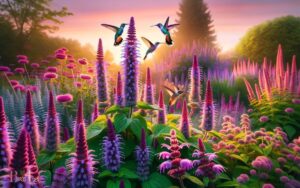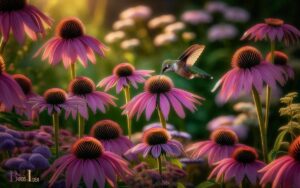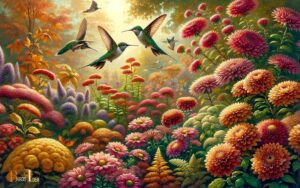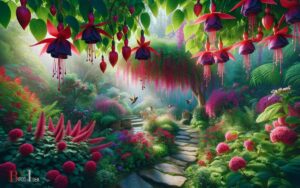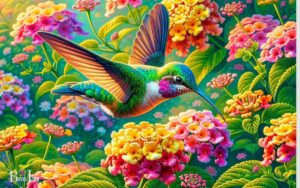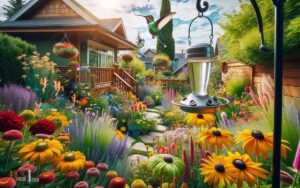Best Food to Attract Hummingbirds: Discover!
To attract hummingbirds, your garden should offer a variety of nectar-rich flowers such as bee balm, zinnias, salvia, and petunias.
Additionally, hanging hummingbird feeders filled with a sugar-water solution (4 parts water to 1 part white sugar) can supplement their diet.
Avoid red dye in the mixture, as it may be harmful to the birds. Offering a consistent food source will encourage these delightful visitors to return to your yard.
Create a hummingbird haven by incorporating vibrant flowers and clean feeders in your garden to enjoy the mesmerizing sight of these tiny, energetic birds all season long.
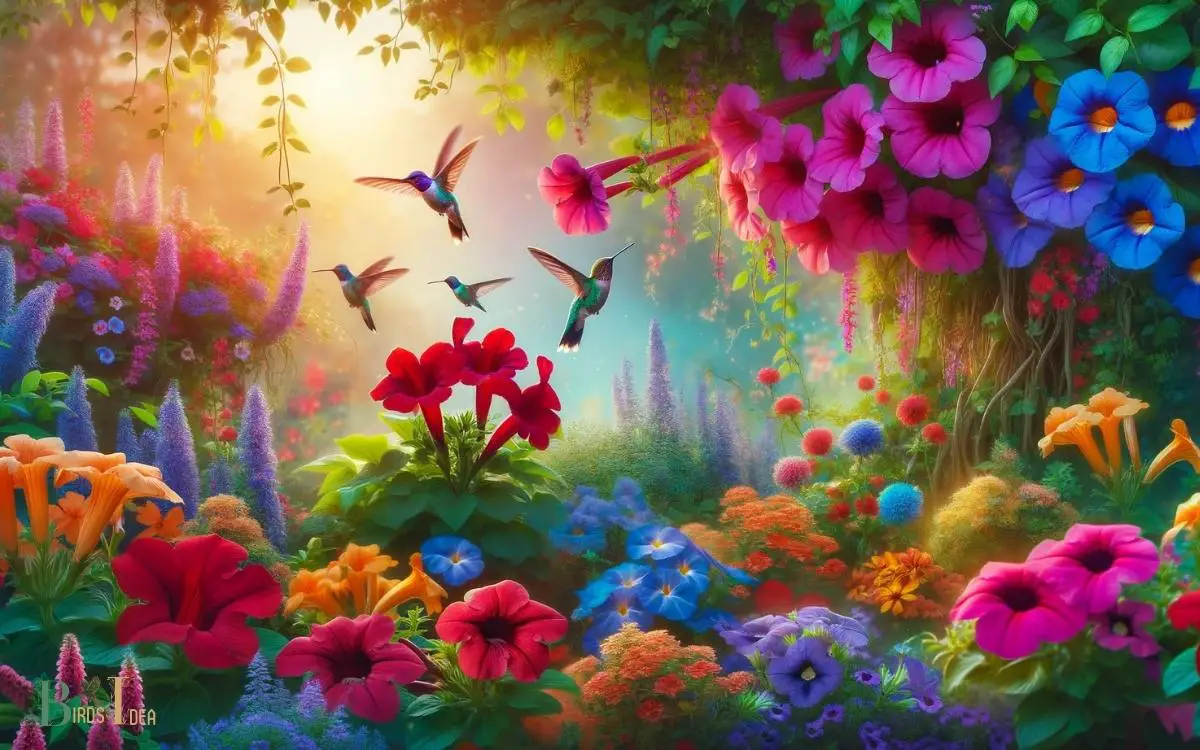
Key Takeaway
Choosing the Right Nectar
Hummingbird enthusiasts often overlook the importance of choosing the right nectar to attract these tiny birds to their feeders.
It’s crucial to use a nectar that closely mimics the natural nectar found in flowers, as this is the hummingbird’s primary food source. The ideal nectar should be clear and free from artificial colors or sweeteners.
Many experts recommend a solution of four parts water to one part table sugar, as this closely resembles the sucrose levels found in natural flower nectar.
It’s important to avoid using honey, brown sugar, or artificial sweeteners, as these can be harmful to the birds.
By carefully selecting the right nectar, hummingbird enthusiasts can ensure that their feeders attract these delightful creatures and provide them with a healthy and nourishing food source.
Planting Hummingbird-Friendly Flowers
When it comes to attracting hummingbirds, planting colorful nectar-producing blooms is key. Native plant species are also important for providing a natural food source for these birds.
Additionally, selecting continuous blooming flowers ensures a steady supply of food throughout the hummingbird season.
Colorful Nectar-Producing Blooms
To attract hummingbirds, gardeners should plant at least three different types of colorful nectar-producing blooms in their garden.
Hummingbirds are attracted to bright and vibrant flowers that produce ample nectar, providing them with the energy they need.
When selecting flowers, it’s important to choose a variety that blooms at different times to ensure a continuous nectar supply throughout the hummingbird season.
Here are some popular options for colorful nectar-producing blooms that are sure to attract hummingbirds:
| Flower Type | Color | Blooming Season |
|---|---|---|
| Trumpet Vine | Orange/Red | Summer to Fall |
| Bee Balm | Red/Pink/Purple | Summer to Fall |
| Columbine | Red/Yellow | Spring to Summer |
| Salvia | Red/Purple | Summer to Fall |
These colorful blooms will not only attract hummingbirds but also add beauty to the garden.
Native Plant Species
Planting hummingbird-friendly flowers requires selecting native plant species that are well-adapted to the local environment and provide a sustainable nectar source for these graceful birds.
Native plants have evolved alongside local wildlife, making them an ideal choice for attracting hummingbirds.
When choosing native plant species, it’s essential to consider the bloom time, as hummingbirds rely on a consistent nectar supply throughout the year.
Some popular native plant options for attracting hummingbirds include trumpet vine, cardinal flower, bee balm, and native honeysuckle.
These plants not only provide nectar but also offer a natural habitat for hummingbirds to perch and nest.
By incorporating native plant species into the garden, individuals can create a welcoming environment for hummingbirds while contributing to the preservation of local ecosystems.
These flowers not only offer a long blooming period but also produce nectar-rich blooms that are highly attractive to hummingbirds, making them excellent choices for a garden aimed at attracting these beautiful creatures.
Providing Protein-Rich Insects
Hummingbirds rely on protein-rich insects to supplement their nectar-based diet, ensuring they receive essential nutrients for their high-energy lifestyle.
Small spiders, gnats, fruit flies, and other tiny insects are essential protein sources for hummingbirds.
These insects provide the necessary amino acids that are not found in nectar, supporting the hummingbirds’ muscle development, feather maintenance, and overall health.
To attract insects, it’s important to have a diverse garden with a variety of plants and flowers that can harbor insects.
Additionally, providing a water source, such as a small birdbath, can attract insects for the hummingbirds to feed on.
While nectar is the primary source of energy for hummingbirds, the addition of protein-rich insects is crucial for their overall well-being and should be considered when creating a hummingbird-friendly environment.
Avoiding Harmful Additives and Chemicals
While it is important to attract insects to support the dietary needs of hummingbirds, avoiding harmful additives and chemicals in the garden is crucial for their well-being.
Hummingbirds can be negatively impacted by pesticides, herbicides, and chemical fertilizers.
To ensure a safe environment for these delicate creatures, consider the following tips:
- Use natural alternatives: Instead of chemical pesticides, opt for natural solutions like neem oil or insecticidal soap to control pests without harming hummingbirds.
- Choose organic fertilizers: Organic fertilizers are free from synthetic chemicals and provide a safer option for hummingbird-friendly gardens.
- Plant native species: Native plants are more resistant to local pests and diseases, reducing the need for chemical interventions.
- Create a chemical-free zone: Designate a specific area of the garden where no chemicals are used to provide a safe haven for hummingbirds.
Attracting Hummingbirds With Fruit Juice
With fruit juice being a popular choice, many gardeners have successfully attracted hummingbirds.
Hummingbirds are naturally attracted to the sweet taste of fruit juices, making it an effective way to entice these tiny birds into your garden.
Here are some tips for using fruit juice to attract hummingbirds:
- Use pure, natural fruit juices without added sugars or artificial sweeteners.
- Offer a variety of fruit juice flavors to appeal to different hummingbird preferences.
- Dilute the fruit juice with water to achieve the perfect sweetness level for hummingbirds.
- Change the fruit juice mixture frequently to prevent fermentation and spoilage, which can be harmful to hummingbirds.
Maintaining Clean and Fresh Food Sources
To keep hummingbirds coming back, it’s crucial to regularly replace nectar and clean feeders weekly.
This helps maintain a fresh and clean food source, ensuring the hummingbirds have access to high-quality nectar.
By following these maintenance steps, bird enthusiasts can create an inviting environment for their tiny, colorful visitors.
Regularly Replace Nectar
Hummingbirds are attracted to feeders that are regularly replenished with clean and fresh nectar.
To maintain a welcoming environment for these delightful birds, it’s crucial to replace nectar at the right intervals.
Here’s how to do it effectively:
- Frequency: Refill feeders every 3-4 days, even in cooler weather, to prevent fermentation and spoilage.
- Cleaning: Thoroughly clean feeders with hot water and a bottle brush every time the nectar is changed to remove any mold or bacteria.
- Storage: Store any unused nectar in the refrigerator for up to a week to keep it fresh.
- Seasonal Changes: In hotter climates, nectar may need to be replaced more frequently, and in cooler climates, it can last a bit longer.
Clean Feeders Weekly
Maintaining clean feeders weekly is essential for providing a consistently fresh and safe food source for hummingbirds.
Regular cleaning prevents the growth of mold and the transmission of harmful bacteria, ensuring the well-being of these delicate creatures.
Here is a simple table to illustrate the impact of clean feeders on hummingbird health:
| Clean Feeders Weekly | Neglected Feeders |
|---|---|
| Healthy, thriving birds | Risk of illness |
| Sustained visits | Decreased visits |
| Vibrant plumage | Dull feathers |
| Longer lifespan | Shortened lifespan |
Conclusion
As the delicate and graceful hummingbird flits from flower to flower, it symbolizes the beauty and wonder of nature.
By choosing the right nectar, planting hummingbird-friendly flowers, providing protein-rich insects, avoiding harmful additives, and setting up a clean and fresh food source, anyone can attract these enchanting creatures to their garden.
With a little effort, anyone can create a welcoming environment for these magical birds and enjoy their presence all season long.

